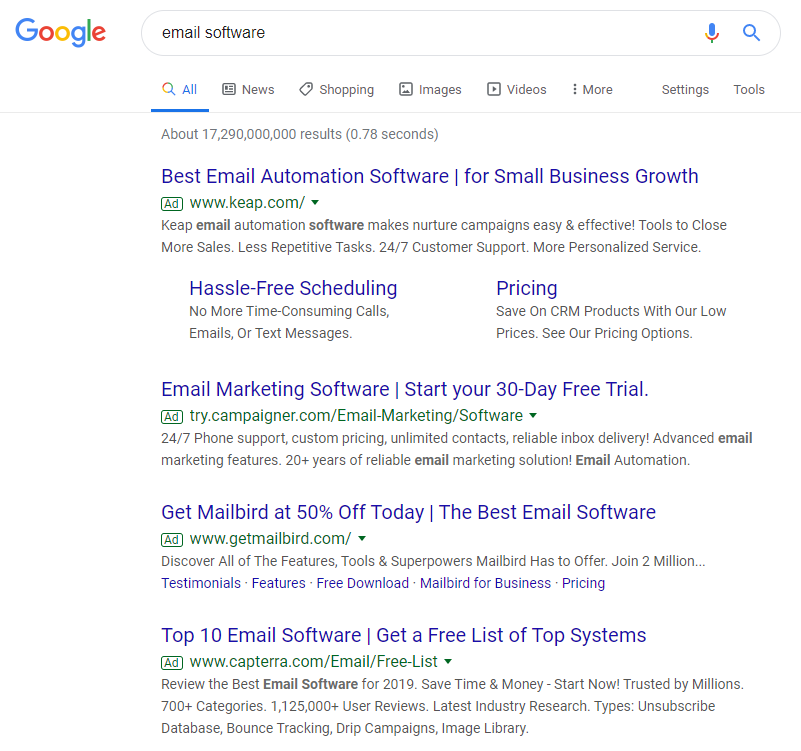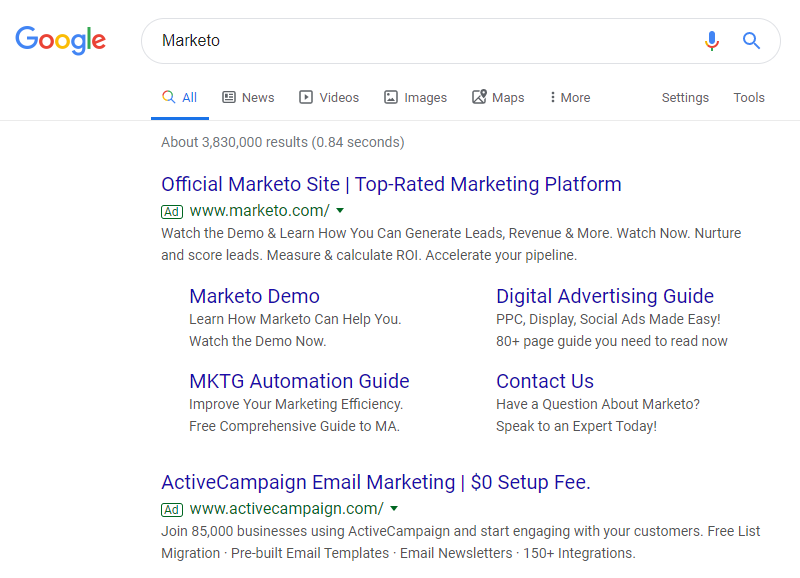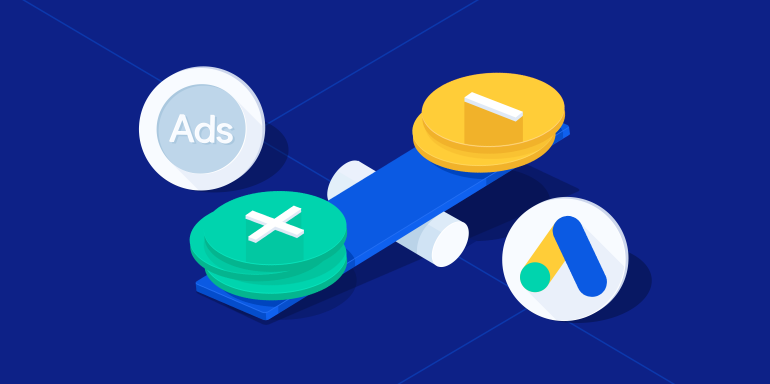Bidding on competitor keywords has become common practice for PPC advertisers because when done correctly, it can significantly increase brand awareness, traffic, and even customer acquisition. After all, if someone is looking for your direct competitor’s products or services, they’re likely interested in yours, too.
But, if you’re not careful, you could end up worse off than you started, with a low CTR, a worse Quality Score, and more expensive ads. So rather than blindly jumping into competitor targeting, let’s first take a look at what it is, the pros and cons, and some examples to help you decide whether or not you should bid on competitor keywords.
What is competitor targeting?
In PPC campaigns, competitor targeting refers to bidding on competitor keywords to reach people searching for alternative brands.
This can be done directly, by bidding on competitor brand names as keywords — or indirectly, by using broad or phrase match keywords (without adding your competitor names as negative keywords). Either way, their potential customers are likely to notice your ads too.
For example, with a branded search for BigCommerce — one of the world’s top ecommerce platforms — we see that two other similar companies, Moovweb and Bolt, are bidding on that brand name:

Why are those other two brands bidding on their competitors’ keywords? And on a branded search, nonetheless?
Simple — they want their name in front of people already brand-aware of BigCommerce. They want to steal potential traffic and leads from the well-established, competing company for as little cost as possible.
Is competitor targeting effective?
When implemented correctly, yes.
Advertisers using the strategy aren’t paying unless they drive a click or gain a substantial amount of impressions. So, even if the user clicks the competitor ad they were initially searching for, the other bidding companies still earn some all-important brand awareness. Consider the example above — the Moovweb and Bolt ads likely made people at least reconsider their decision to choose BigCommerce.
Max Serrato, PPC Specialist at Directive, answers the question further:

If you have a strategy behind it, yes. If you are bidding on ‘competitor name’ + modifiers like ‘alternatives, pricing, etc.’ and have the ad copy and a landing page that matches the intent, you can see excellent results.
An example would be sending users to a page that compares your brand’s prices to another brand’s prices. Another could be sending them to an analyst report that compares both companies, or a page that highlights user reviews for each company. Simply bidding on a competitor's brand name only, and sending them to a general page on your site likely won’t work.
Aaron Levy of Tinuity also shares his thoughts:

Yes, but exercise caution. Bidding on competitor brand names is a viable strategy to conquest, but keep user intent in mind as you develop your campaigns. Competitor brand terms inherently have high CPCs, often higher than your normal non-branded terms; just as with brand. You must be purposeful with your copy and ensure you’re touting benefits rather than features.
I wouldn’t necessarily recommend bidding on a competitor's core name unless there’s a truly compelling reason to do so. If I’m the SEM manager for Marketo, I wouldn’t bid on the term HubSpot unless it was paired with a high intent remarketing audience. Instead, I would build a focused strategy on capturing potential customers in the research phase, bidding on terms like HubSpot vs., HubSpot competitors, HubSpot reviews, or HubSpot pricing.
Bidding on competitor terms isn’t as simple as creating a new campaign and targeting someone else’s keywords. As Max said, you can’t merely bid on a competitor’s brand name and hope they end up on your website, driving higher conversion rates. There’s more to it, as we’ll see in the examples to follow.
First, here are several pros and cons to consider before diving into competitor targeting.
Pros to bidding on competitor keywords
1. Less competition
Aside from the competitor brand you’re bidding on, there are typically fewer advertisers bidding on competitor keywords than their own terms.
If you’re bidding on “email software,” for example, you have to compete with every business that sells any email software — from basic B2B email marketing software, to advanced email automation solutions, to B2C email servers, and everything in between:

On the other hand, if you bid on “Mailchimp,” you’re only competing with Mailchimp and possibly a few other brands that are also bidding on competitor brand names.
What’s more, lower competition generally means lower CPC, so bidding on competitor keywords in Google Ads can be a more cost-effective option. This is especially true if the competitor isn’t bidding on their own brand name, or engaging in any PPC campaigns because you have the opportunity to show up above their first listing in the organic results like this:

2. You get more brand awareness
Another great benefit of Google Ads and bidding on competitor brand names is that it helps you gain brand awareness. This doesn’t apply as much to larger, well-known companies (because people aren’t likely to be unfamiliar with them). Still, on a smaller scale, you can gain brand awareness by reaching the audience your competitors have already established.
Anyone searching for your competitors will see your brand pop up in the search ads results and may start to consider you as an option, too. It puts your brand in the conversation, and serves as a good way of saying, “Hey! Have you heard of us? We can help too!”
This is especially true if searchers haven’t made a final decision to do business with your competitor — perhaps they have issues and may be looking for a reason to jump ship. Bidding on their keywords and showing up right alongside them presents them (and you) with another opportunity.
For this to work, though, your ad must be well branded and highlight what makes your company and offer superior. Notice how ActiveCampaign uses Google Ads to bid on competitor keywords and makes sure to include their $0 setup fee in the ad headline to capture users’ attention:

3. A qualified audience
One of the greatest benefits of bidding on competitors’ brand names is that it guarantees a qualified audience for your offer. The majority of people searching for your competitor’s brand name, product, or service are also in the market for you. It’s essentially a way of pre-qualifying them, meaning they’ll have higher intent and will be more likely to click/convert.
Again, be sure to highlight your UVP in the ad headline to point out that your brand is better (stronger, faster, most cost-effective, etc.) than your competitor’s. That way, anyone searching for your competitor will see both ads, and take note of why they should click yours above all others.
Despite these three major benefits, there are also a few downsides to bidding on competitor keywords on Google Ads.
Cons to bidding on competitor keywords
1. Potential for a bidding war
Imagine you do a Google search for your own brand name and see competitor ads. You may not be happy about it and you might even be enticed to start bidding on their branded terms too, which could be the case between Demandbase and Terminus:


By bidding on a competitor’s name, you’re openly inviting them to bid on yours too — leading to a potential bidding war.
This is a high-risk digital ad strategy for two reasons:
- While you’re bidding on brand names and making it more expensive for them to bid on their own name, it goes the other way too — their bidding on your brand name makes it more expensive for you to convert on your own brand.
- If public perception favors your competition when competitors start bidding on your keywords, they’ll poach more of your traffic than you poach of theirs.
If you plan to bid on competitor keywords, keep in mind that whatever impact your ads have on a competitor’s campaign performance (lower impression share, lower CTR, higher CPC), the same may also occur for your own campaign if the competitor decides to retaliate. This sort of bidding war can become expensive and wasted ad spend for both sides.
2. Low CTR (and lower quality score)
When someone does an online search for a specific brand, chances are they already have their mind set on buying from that brand. They may not have anything against your business — or even be aware of it — but they may have a good reason to be loyal to the other brand. So even if your ad shows up right alongside theirs, most people will likely still click the competitor’s, bringing down your click-through rate.
While this may not seem so bad since you’re not paying unless someone clicks your ad or you gain significant brand awareness, low CTR can cause your Quality Score to drop due to the way it’s calculated:

This makes it more expensive for your ad to show, so in a way, you’re still at a disadvantage when someone doesn’t click your ad.
3. Potential legal implications
If competitor brand bidding is done incorrectly, there can be massive penalties and even legal ramifications. So, although it’s tempting to boast about why your product is superior to the competition, you should be well-versed in Google Ad policies before setting up your competitor brand name targeting.
Google allows search engine advertisers to bid on their competitors keywords, but according to Google’s Trademark Rules, you must avoid:
- Trademarked brand names in your ad text — You can’t say, “Even better than X brand!” or “20% cheaper than X!”
- Trademarked brand names in your display URL — Your display URL can’t say “www.site.com/better-than-X”.
Google says:
If a trademark owner submits a complaint to Google about the use of their trademark in Google Ads ads, we will review it and may enforce certain restrictions on the use of that trademark.
There are several exceptions to the trademark rules because Google recognizes that third parties may need to use trademarks in certain situations such as:
- Resellers — If you are a dealer that sells branded items, you can advertise using those trademarks.
- Informational sites — If you are an information-based site (such as Consumer Reports or CNet) you can use trademarked names.
- Authorized advertisers — If the owner of the trademark has given you authorization to use it, you are free to use the trademark.
On this note, it’s critical to make sure your own brand is trademarked and protected. If it’s not, someone can easily put your company name in their ads like Moengage does with Swrve:

If you haven’t already done so, you can visit the United States Patent and Trademark Office site (or the corresponding site for your Country) to start the brand name trademark process.
3 Examples of competitor targeted keywords
1. HelloFresh
All of the brands featured below bid on “HelloFresh” as one of their keywords, while it doesn’t appear as if HelloFresh bids on its own name:

Notice how each ad is concise and descriptive, highlighting the company’s unique value proposition:
- Noom points out that their offer is actually a weight loss program.
- Home Chef offers an $80 discount, explaining that customers are getting more bang for their buck with their meal kit delivery service.
- Martha & Marley Spoon offers $80 off 4 different meal kits.
- Blue Apron includes a time-sensitive $60 off coupon, and goes as far as to say that they are “better” without breaking any rules by putting HelloFresh’s name in their ad copy
All of the ads also include ad extensions to help improve the user experience and increase visibility, click-through rate, and post-click landing page views.
What’s more, Noom, Home Chef, and Blue Apron all direct prospects to dedicated, relevant post-click landing pages where they can learn more about the specific offer before selecting which company to purchase from.
2. Mixpanel
Each of the following brands bid on Mixpanel as a competitor keyword, and this time, Mixpanel also bids on its own name:

Again, the three companies surrounding Mixpanel each highlight their own UVP:
- Pendo is fast, actionable, and code-free.
- Keen offers customizable solutions and affordable pricing.
- Heap advertises “better” analytics with an offer for a competitive kit.
The Pendo and Heap ads include extensions for a better user experience and increased visibility, CTR, and post-click page views. Plus, both brands connect their ads to relevant post-click landing pages that complete the ad’s narrative.
Pendo’s page explains why Pendo is the better option by including a brief comparison to Mixpanel:

Heap takes their competitor targeting strategy further by creating an entire post-click page about their competition with Mixpanel:

3. Zoho
Like HelloFresh, it doesn’t appear as if Zoho bids on their own name either. However, the other four companies below all bid on Zoho as a competitor keyword:

As expected, all four brands include a UVP in their ad copy:
- Affinity boasts about being the #1 CRM for venture capital
- Mailchimp highlights that their CRM platform is free
- Vendavo offers proven profit optimization
- Accelo promotes its synchronized and intelligent software
The first three ads contain ad extensions to improve the user experience and offer detailed information to search users.
In this example, Accelo is the only brand that completes their campaign with a relevant post-click landing page, comparing their product to Zoho’s and highlighting the benefits of choosing Accelo:

Gain a pre-approved audience by bidding on competitor keywords
Bidding on competitors’ brand names can boost your online advertising performance, because if someone is already aware of your competitor’s products or services, they could be interested in yours, too. However, this ad strategy only works if you pay attention to the pros and cons and abide by Google’s Trademark Rules.
Use inspiration from brands like Accelo, Heap, and Pendo to connect your entire user experience from ad to post-click stage, and request an Instapage Enterprise Demo today to see how Instapage can help you build personalized post-click landing pages at scale.

See the Instapage Enterprise Plan in Action.
Demo includes AdMap™, Personalization, AMP,
Global Blocks, heatmaps & more.
